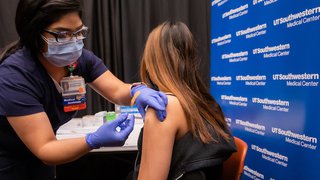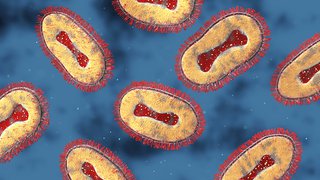
Using genomic sequencing, scientists at UT Southwestern confirmed the first case of the Omicron variant in Dallas on Dec. 13. Since then, the highly transmissible variant has spread at a dizzying pace, eclipsing the Delta variant across the U.S. and accounting for about 90% of sequenced cases in Texas.
COVID-19 test positivity rates are rising across the state, and UT Southwestern's forecasting model is projecting the number of hospitalizations in the Dallas-Fort Worth region will rise as well.
Every day, we’re learning more about this heavily mutated variant, which was first identified in South Africa. Recently, I joined my colleagues Julie Pfeiffer, Ph.D., a Professor of Microbiology, and John Warner, M.D., Executive Vice President for Health System Affairs at UT Southwestern, for a discussion about Omicron’s evolution on the UTSW web series “What to Know.”
Evolving Omicron
The emergence of the highly mutated, fast-spreading variant is creating a winter surge of COVID-19 cases. Dr. Trish Perl, Chief of Infectious Diseases at UT Southwestern, and Dr. Julie Pfeiffer, a UTSW Professor of Microbiology who studies virus evolution, offer insights on the trajectory of Omicron and how it stacks up against the vaccines.
Below are excerpts from our Q&A focusing on key concerns for patients, including:
- The severity of illness associated with this new variant
- How vaccines and booster shots protect against Omicron
- How we should approach the holidays and winter months as Omicron is expected to surge
How does Omicron differ from Delta?
Omicron has about 50 mutations – a lot more than we’ve seen on any other variants. And at least 30 of those mutations are on the spike protein, which allows the virus to penetrate cells and cause infection. Early research has shown that Omicron is anywhere from two to three times more transmissible than Delta. It also can evade some of the immune mechanisms in place, meaning that vaccines are not quite as effective against Omicron, and some of the monoclonal antibody treatments are not working.
With Omicron, we will see a lot of infections very, very quickly. There are some early indications that Omicron may cause less severe disease than Delta. A study by the University of Hong Kong, which has not been peer-reviewed yet, found Omicron replicates faster higher up in the respiratory tract but it doesn't cause as much severe infection in the lungs.
Nonetheless, this new variant is certainly going to create a lot of illness and heartache, and it is likely to impede some of the things we would like to do given its level of transmissibility.
Are we seeing different symptoms with Omicron?
Yes. Vaccinated individuals are reporting milder symptoms – more like the common cold. We are also not seeing as many vaccinated people being hospitalized. In the unvaccinated population, however, we are still trying to understand whether their symptoms differ immensely. It may also be that they are presenting with milder symptoms, but we’ll have to study that more as cases increase. The loss of taste and smell, which was among the most telling symptoms from previous variants, seems to be less common with Omicron. But that is based primarily on early anecdotal evidence, not confirmed research.
Do vaccines protect against the Omicron variant?

Vaccine and booster shot registration
Everyone age 5 and older is eligible to receive a COVID-19 vaccine, and individuals 16 and older can receive booster shots. For information about COVID-19 vaccination at UT Southwestern, please visit our COVID-19 web page.
We have the most information about the Pfizer and Moderna mRNA vaccines, and it appears overall that the vaccine effectiveness is much lower against Omicron the further out you are from completing your second dose. But new data show that vaccine effectiveness increases up to 70% to 75% once you've had a booster.
In fact, because of this variant’s ability to evade immunity, in the U.K. they are going to start boosting people three months after the second dose as opposed to six months, which is what the Centers for Disease Control and Prevention (CDC) has currently recommended in the U.S.
How often do you think we’ll need booster shots?
It’s too soon to say. We have to see how the virus evolves and how nimble we are in creating new vaccines, which is the beauty of these mRNA vaccines – they can be reformulated very quickly in the lab. So, we really have to wait and see how we respond.
That being said, the most important thing is to make sure people get fully vaccinated with boosters because that will decrease the amount of virus that's circulating so it can’t mutate further.
How should we approach the holidays with Omicron emerging?
Absolutely we need to be masking, especially in public places with individuals we don't know, because we don't know their vaccination status or if they’re symptomatic. We know masks work. We also need to be cognizant of physical distancing, which also works. Ventilation will be important. If you can gather outdoors, that's going to be better than indoors.
Finally, we may see the rollout and utilization of home-based rapid tests as a strategy to make sure people are not infectious. That strategy has been used a lot in Europe. I think at-home tests could become very important to help us feel more comfortable. We want to normalize, but we want to normalize in a way that’s safe for everyone.
What do you think this will look like a year or two from now?
I think we're going to have a few more waves – that's the natural evolution and adaptation of the virus to this environment. The virus is probably going to become seasonal, very much like other coronaviruses and respiratory viruses, which means we may fall into a pattern where we'll see it in the fall and winter.
We are still going to have some individuals with more severe disease or complications from the infection. As immunity builds in the population, we will likely have a lot more milder infections. That's my prediction.
For more information and updates about UT Southwestern’s pandemic response, testing, vaccines, and booster shots, please visit our COVID-19 website.
Hunting for COVID variants
At UT Southwestern, research by Jeffrey SoRelle, M.D., and colleagues in the Eugene McDermott Center for Human Growth and Development’s Next Generation Sequencing Core shows how the COVID-19 virus is changing in North Texas. Specifically, it indicates which strains of the virus are moving through the region to help policymakers and public health authorities respond to and fight the pandemic.













